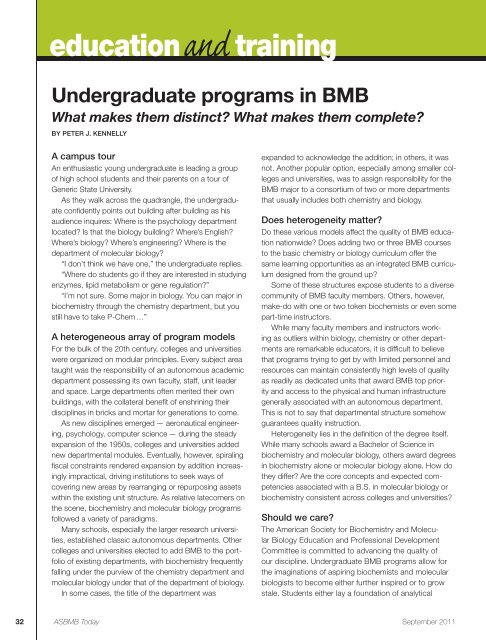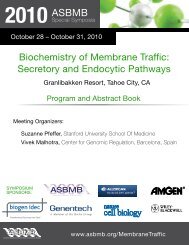asbmbnews
asbmbnews
asbmbnews
Create successful ePaper yourself
Turn your PDF publications into a flip-book with our unique Google optimized e-Paper software.
education and training<br />
Undergraduate programs in BMB<br />
What makes them distinct? What makes them complete?<br />
BY PETER J. KENNELLY<br />
A campus tour<br />
An enthusiastic young undergraduate is leading a group<br />
of high school students and their parents on a tour of<br />
Generic State University.<br />
As they walk across the quadrangle, the undergraduate<br />
confidently points out building after building as his<br />
audience inquires: Where is the psychology department<br />
located? Is that the biology building? Where’s English?<br />
Where’s biology? Where’s engineering? Where is the<br />
department of molecular biology?<br />
“I don’t think we have one,” the undergraduate replies.<br />
“Where do students go if they are interested in studying<br />
enzymes, lipid metabolism or gene regulation?”<br />
“I’m not sure. Some major in biology. You can major in<br />
biochemistry through the chemistry department, but you<br />
still have to take P-Chem …”<br />
A heterogeneous array of program models<br />
For the bulk of the 20th century, colleges and universities<br />
were organized on modular principles. Every subject area<br />
taught was the responsibility of an autonomous academic<br />
department possessing its own faculty, staff, unit leader<br />
and space. Large departments often merited their own<br />
buildings, with the collateral benefit of enshrining their<br />
disciplines in bricks and mortar for generations to come.<br />
As new disciplines emerged — aeronautical engineering,<br />
psychology, computer science — during the steady<br />
expansion of the 1950s, colleges and universities added<br />
new departmental modules. Eventually, however, spiraling<br />
fiscal constraints rendered expansion by addition increasingly<br />
impractical, driving institutions to seek ways of<br />
covering new areas by rearranging or repurposing assets<br />
within the existing unit structure. As relative latecomers on<br />
the scene, biochemistry and molecular biology programs<br />
followed a variety of paradigms.<br />
Many schools, especially the larger research universities,<br />
established classic autonomous departments. Other<br />
colleges and universities elected to add BMB to the portfolio<br />
of existing departments, with biochemistry frequently<br />
falling under the purview of the chemistry department and<br />
molecular biology under that of the department of biology.<br />
In some cases, the title of the department was<br />
expanded to acknowledge the addition; in others, it was<br />
not. Another popular option, especially among smaller colleges<br />
and universities, was to assign responsibility for the<br />
BMB major to a consortium of two or more departments<br />
that usually includes both chemistry and biology.<br />
Does heterogeneity matter?<br />
Do these various models affect the quality of BMB education<br />
nationwide? Does adding two or three BMB courses<br />
to the basic chemistry or biology curriculum offer the<br />
same learning opportunities as an integrated BMB curriculum<br />
designed from the ground up?<br />
Some of these structures expose students to a diverse<br />
community of BMB faculty members. Others, however,<br />
make-do with one or two token biochemists or even some<br />
part-time instructors.<br />
While many faculty members and instructors working<br />
as outliers within biology, chemistry or other departments<br />
are remarkable educators, it is difficult to believe<br />
that programs trying to get by with limited personnel and<br />
resources can maintain consistently high levels of quality<br />
as readily as dedicated units that award BMB top priority<br />
and access to the physical and human infrastructure<br />
generally associated with an autonomous department.<br />
This is not to say that departmental structure somehow<br />
guarantees quality instruction.<br />
Heterogeneity lies in the definition of the degree itself.<br />
While many schools award a Bachelor of Science in<br />
biochemistry and molecular biology, others award degrees<br />
in biochemistry alone or molecular biology alone. How do<br />
they differ? Are the core concepts and expected competencies<br />
associated with a B.S. in molecular biology or<br />
biochemistry consistent across colleges and universities?<br />
Should we care?<br />
The American Society for Biochemistry and Molecular<br />
Biology Education and Professional Development<br />
Committee is committed to advancing the quality of<br />
our discipline. Undergraduate BMB programs allow for<br />
the imaginations of aspiring biochemists and molecular<br />
biologists to become either further inspired or to grow<br />
stale. Students either lay a foundation of analytical<br />
32 ASBMB Today September 2011






